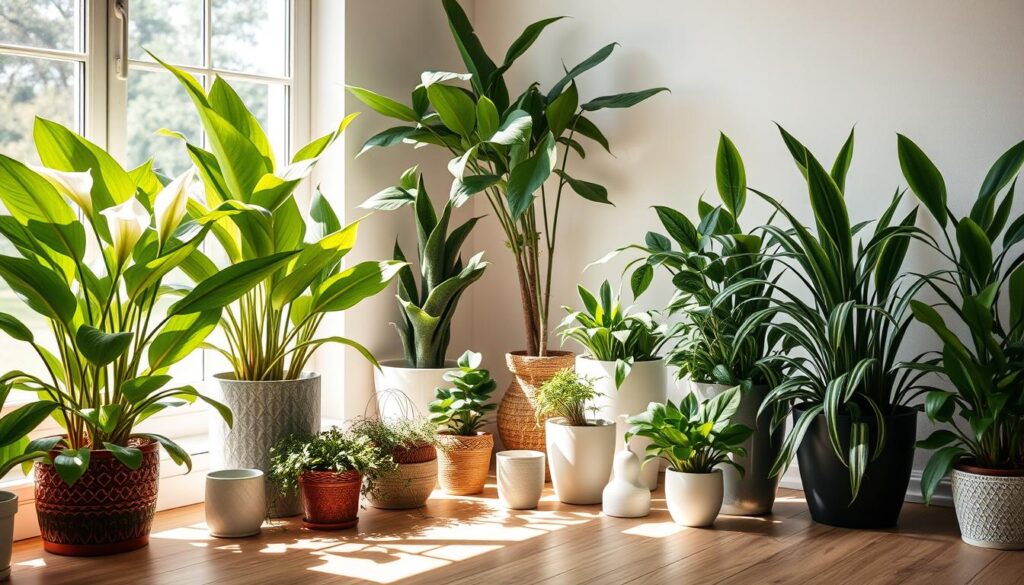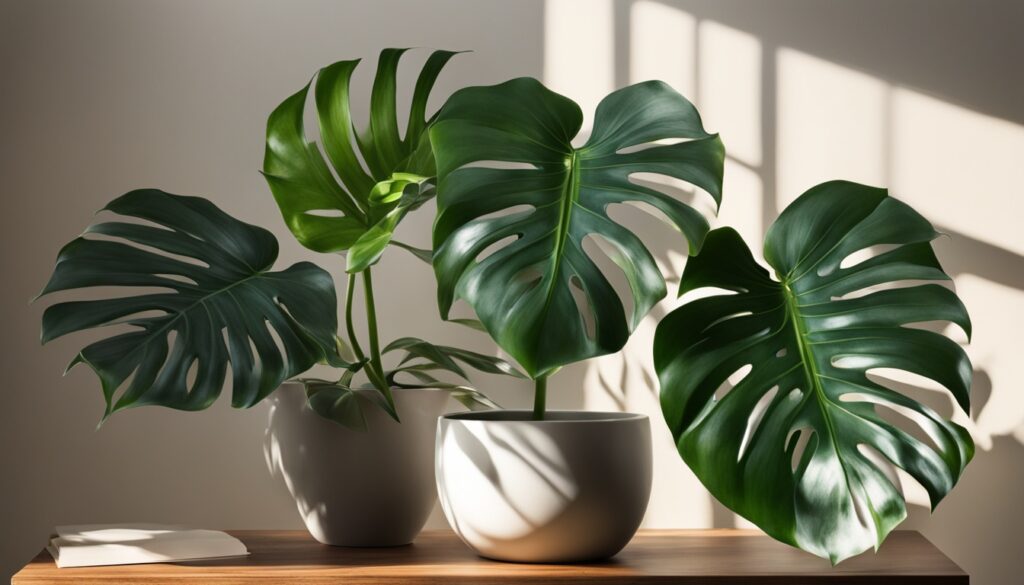Do you find yourself sneezing and itching a lot indoors? The answer might be in your home. Indoor plants can change the air in your home, making it healthier. But, not all plants are good for people with allergies. So, what are the top plants for allergy sufferers?
Key Takeaways:
- Certain indoor plants can effectively remove common indoor air pollutants, including formaldehyde, benzene, and carbon monoxide.
- The Ogren Plant Allergy Scale (OPALS) rates plants based on their likelihood to cause allergies, helping you choose hypoallergenic options.
- NASA research has identified specific plants that excel at air purification, making them ideal for creating an allergen-free home.
- Proper plant care, including maintaining humidity and preventing dust buildup, is crucial for maximizing the air-purifying benefits of indoor plants.
- Strategic placement and a variety of air-purifying plants can transform your living spaces into a haven for allergy sufferers.
Understanding Indoor Air Quality and Allergies
Indoor air pollution is a big problem, especially for seniors and those with breathing issues. Common pollutants include VOCs, particulate matter, mold spores, and tobacco smoke. These can harm indoor air quality and cause health problems like allergies and breathing issues.
Common Indoor Air Pollutants
- Volatile Organic Compounds (VOCs): Found in household cleaners, paints, and other products, VOCs can be harmful when inhaled.
- Particulate Matter: Tiny particles and dust from various sources, such as cooking, can exacerbate allergy symptoms.
- Mold Spores: Thriving in damp environments, mold spores can trigger allergic reactions and respiratory issues.
- Tobacco Smoke: Secondhand smoke contains a cocktail of toxic chemicals that can worsen indoor air quality.
How Indoor Plants Impact Air Quality
Fortunately, indoor plants can improve indoor air quality. NASA’s Clean Air Study found some houseplants can filter out toxins like benzene, formaldehyde, and trichloroethylene. Plants like Peace Lily, Snake Plant, and Chinese Evergreen are great at removing harmful pollutants, making homes healthier.
The OPALS Rating System Explained
The OPALS (Ogren Plant Allergy Scale) rating system helps find plants that are less likely to cause allergies. It ranges from 1 to 10, with lower numbers meaning plants are less allergenic. Choosing plants with a lower OPALS rating helps people with allergies enjoy indoor plants without worsening their symptoms.
Why Your Home’s Air Quality Matters
The air we breathe indoors greatly affects our health. Poor air quality can make breathing harder, trigger allergies, and raise the risk of infections. This is especially true for seniors and those with weak immune systems. Clean air can help them feel better, breathe easier, and stay healthy.
Studies reveal indoor air is 2-5 times dirtier than outdoor air. This makes keeping our homes well-ventilated and clean very important. Air-purifying plants for allergy sufferers help by cleaning the air and making us feel calmer.
| Pollutant Source | Potential Impact |
|---|---|
| Synthetic building materials, furnishings, and cleaning products | Contribute up to 90% of indoor air pollution |
| Pollen, dust mites, pet dander | Trigger allergic reactions and respiratory issues |
| Carbon monoxide, carbon dioxide, nitrogen dioxide | Impair lung function and cardiovascular health |
To tackle indoor air quality issues, we need a few strategies. Using HEPA air filters, changing furnace filters often, and placing air-purifying plants for allergy sufferers around your home are good steps. These actions help create a healthier living space. By doing so, you can find natural allergy relief with houseplants and enhance your life quality.
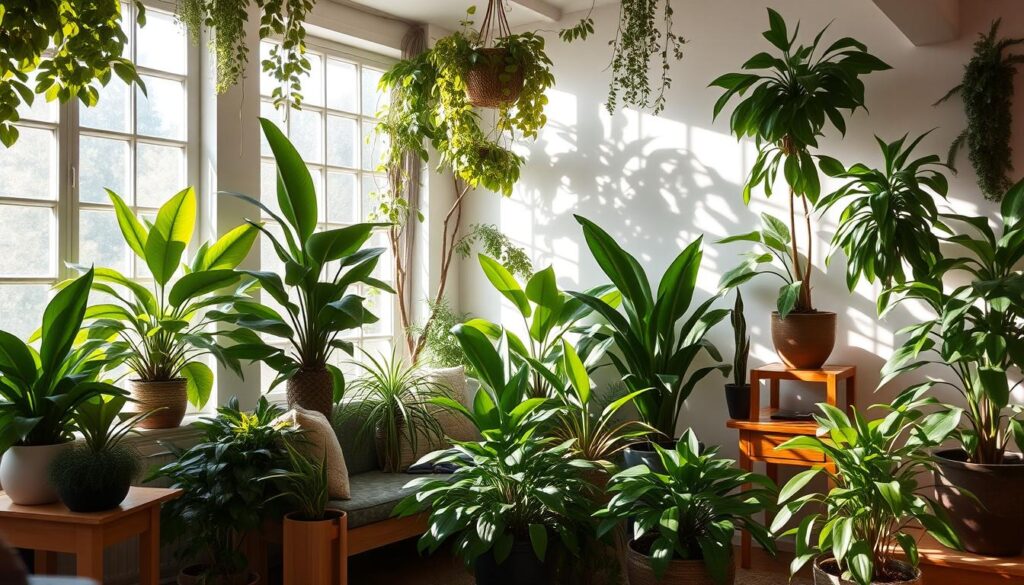
“Improving indoor air quality is one of the most effective ways to support respiratory health and overall well-being.”
Best Indoor Plants for Allergies: Top Choices for Clean Air
For those with allergies, the right indoor plants can greatly improve breathing at home. Certain plants stand out for their ability to purify the air. These plants are not only beautiful but also help keep the air clean, making homes safer for allergy sufferers.
Peace Lily (Spathiphyllum)
The peace lily is easy to care for and loves warm, humid places. It’s known for removing harmful toxins like formaldehyde and benzene from the air. Its lush leaves and white flowers also add beauty to any room.
Snake Plant (Sansevieria)
Also called Mother-in-Law’s Tongue, the snake plant is tough and can handle different light levels. It’s great for people with allergies because it removes harmful chemicals from the air. Plus, it’s simple to care for, making it perfect for any home.
Chinese Evergreen (Aglaonema)
The Chinese evergreen is a stunning plant that looks great in low-light areas. It’s known for removing toxins like formaldehyde and benzene from the air. Its colorful leaves and ability to adapt to various lights make it a favorite for those wanting cleaner air.
| Plant | Air-Purifying Benefits | Maintenance Level |
|---|---|---|
| Peace Lily | Removes formaldehyde, benzene, trichloroethylene | Low |
| Snake Plant | Removes formaldehyde, benzene, VOCs | Low |
| Chinese Evergreen | Removes formaldehyde, benzene | Moderate |
These plants not only improve air quality but also add beauty to any space. By choosing these hypoallergenic plants, people with allergies can breathe easier and enjoy a healthier home.
Air-Purifying Plants with NASA Approval
Keeping the air inside your home clean is key for a healthy living space, especially for those with allergies. NASA has found a list of NASA-approved air-cleaning plants that can remove harmful toxins from the air. These best indoor plants for allergies not only take in carbon dioxide and release oxygen. They also get rid of dangerous chemicals like benzene, formaldehyde, and trichloroethylene.
In a 1989 study, NASA found that some household plants can filter out harmful chemicals. For example, the Peace Lily, Corn Plant, and ZZ Plant can remove nitrogen dioxide from the air. The Dragon Tree is good at removing benzene, formaldehyde, and trichloroethylene.
Other plants like the Spider Plant can remove 95% of formaldehyde in just 24 hours. The Weeping Fig is great at cleaning the air of formaldehyde, xylene, and toluene. The Devil’s Ivy (Pothos) and Barberton Daisies are also good at filtering out benzene, formaldehyde, and trichloroethylene.
| NASA-Approved Plant | Toxins Removed |
|---|---|
| Peace Lily | Nitrogen dioxide |
| Corn Plant | Nitrogen dioxide |
| ZZ Plant | Nitrogen dioxide |
| Dragon Tree | Benzene, formaldehyde, trichloroethylene |
| Spider Plant | Formaldehyde |
| Weeping Fig | Formaldehyde, xylene, toluene |
| Devil’s Ivy (Pothos) | Benzene, formaldehyde, xylene |
| Barberton Daisies | Formaldehyde, benzene, trichloroethylene |
NASA suggests having at least one plant for every 100 square feet to purify the air well. Adding these NASA-approved air-cleaning plants to your home can make it healthier and more allergy-friendly for your family.
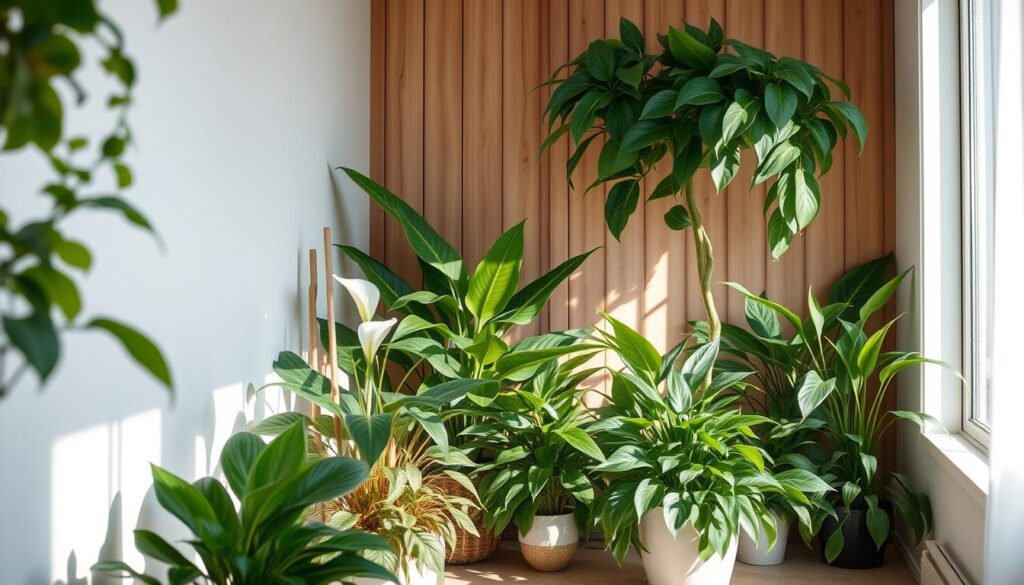
Low-Maintenance Allergy-Friendly Plants
Easy-care allergy-resistant plants are great for a healthy indoor space. They purify the air and add natural beauty. These plants are easy to care for and help keep your home clean.
Boston Fern Benefits
The Boston Fern is perfect for those with allergies. It increases humidity, which helps with breathing. It also removes toxins like formaldehyde from the air.
Adding this easy-care allergy-resistant plant to your home makes the air cleaner and more breathable.
Spider Plant Advantages
The Spider Plant is another good choice for allergy sufferers. It filters out harmful substances like formaldehyde and carbon monoxide. It also absorbs molds and allergens, making the air healthier.
Janet Craig Plant Care
The Janet Craig is a low-maintenance plant for allergies. It’s a slow-growing shrub that thrives in tropical climates. It’s easy to care for and improves air quality without needing a lot of maintenance.
“Incorporating easy-care allergy-resistant plants into your home can make a significant difference in creating a healthier, more breathable environment.”
Plants That Combat Specific Allergens
For those with allergies, knowing which plants can filter out allergens is key. Aloe Vera removes harmful VOCs and has healing properties. The Areca Palm acts as a natural humidifier and cleanses the air of harmful chemicals.
The English Ivy is also a standout, removing harmful substances like benzene and formaldehyde. Adding these hypoallergenic houseplants and air-purifying plants for allergy sufferers can make your home healthier and more breathable.
| Plant | Allergens Removed |
|---|---|
| Aloe Vera | VOCs |
| Areca Palm | Formaldehyde, Xylene, Toluene |
| English Ivy | Benzene, Formaldehyde, Trichloroethylene, Xylene, Toluene |
By adding these hypoallergenic houseplants and air-purifying plants for allergy sufferers to your home, you can fight specific allergens. This creates a healthier, more breathable space.
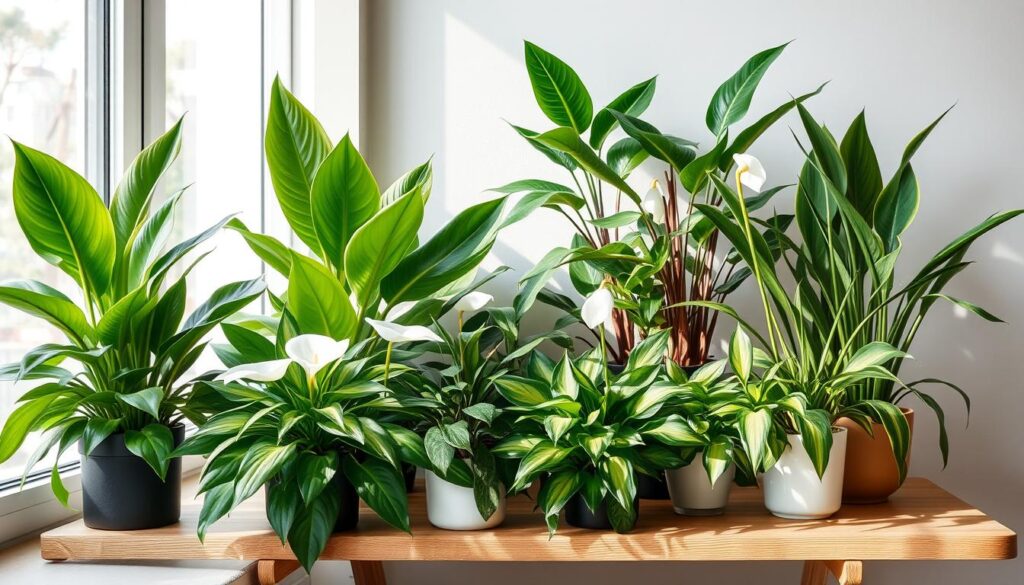
“These plants not only enhance the aesthetic appeal of your home but also actively work to purify the air, providing relief to those with allergies.”
Safe Plants for Pet Owners with Allergies
Choosing the right indoor plants is key when you have pets. Many plants can be harmful to pets, which is a big concern. Luckily, there are pet-friendly plants for allergies that are safe and good for your home’s air.
Non-Toxic Options
Some top hypoallergenic houseplants that are safe for pets are the Spider Plant, Boston Fern, and Areca Palm. These plants clean the air well, removing harmful chemicals. They are safe for your pets, thanks to a NASA study.
Pet-Friendly Choices
- Bamboo Palm
- Prayer Plant
- Gerbera Daisies
- Orchids
- Succulents (such as Echeveria)
- Ponytail Palm
- Catnip
- Money Tree
- Moth Orchid
These plants are not only good for the air but also make your home look beautiful. They are safe for your pets. By picking hypoallergenic houseplants that are safe, you can make a healthy space for everyone.
“Plants aid in removing chemical contaminants such as benzene, formaldehyde and trichloroethylene from indoor air, as per a NASA study.”
| Plant Type | Pet Safety | Air Purifying Ability |
|---|---|---|
| Spider Plant | Safe for pets | Effective at removing up to 95% of airborne chemicals within 24 hours |
| Boston Fern | Non-toxic to pets | Excellent at removing formaldehyde and other pollutants from the air |
| Areca Palm | Pet-friendly | Proven to be highly effective in purifying indoor air |
Indoor Plants to Avoid if You Have Allergies
Creating a healthy indoor space can be tricky if you have allergies. Some plants produce a lot of pollen or mold, making allergies worse. Knowing which plants to avoid is key to a comfortable home.
The Chrysanthemum is a big problem because it makes a lot of pollen. Being around Chrysanthemum pollen can make you sneeze and feel stuffy. Ferns are also bad because their spores can make your breathing and skin problems worse.
Don’t get the Dahlia if you have allergies. Even though some types are okay, Dahlia pollen can still make allergies worse. The Hoya carnosa, or Wax Plant, can also cause allergic reactions like runny nose and coughing.
Stay away from Baby’s Breath and Weeping Fig plants too. Baby’s Breath pollen can make your nose run, eyes itch, and even cause asthma. Weeping Fig can make your skin and breathing problems worse, like a latex allergy.
For a healthy home, choose plants that don’t make pollen or are easy to care for. Peace Lilies, Philodendrons, and Areca Palms are good choices. By picking the right plants and taking good care of them, you can have a clean, allergy-free home.
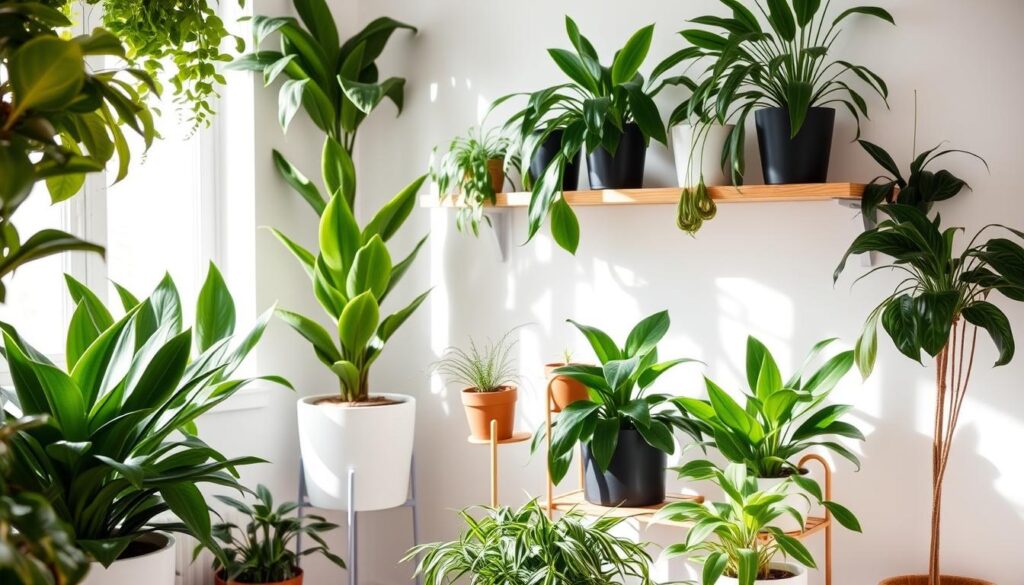
To prevent plant allergies, individuals can opt for non-flowering plants, avoid over-watering, ensure adequate sunlight, and use dehumidifiers.
Proper Plant Care for Allergy Prevention
Keeping your plants well cared for is key to a healthy home. By following a few easy steps, you can make your allergy-friendly indoor gardening space better. This helps reduce allergens and keeps the air clean and healthy.
Watering and Humidity Control
Too much water can cause mold and mildew, making allergies worse. Water your plants regularly but let the soil dry a bit between waterings. Also, keep an eye on humidity levels. Use a dehumidifier if needed to keep humidity between 30-50%.
Dust and Mold Prevention
Wipe down your plants’ leaves often to get rid of dust and pollen. Check your plants for any signs of disease or pests. These can lead to mold and release more allergens into the air.
By following these simple care tips, you can make your home a healthier place. Enjoy the benefits of allergy-friendly indoor gardening without worrying about allergies.
“Proper plant care is the foundation for an allergy-free home. With a little attention to detail, your indoor oasis can become a haven of clean, allergen-free air.”
Placement Strategies for Maximum Air Purification
Getting the most out of air-purifying plants for allergy sufferers means where you put them matters. To get the best results from your allergy-friendly indoor gardening, follow these tips:
- Focus on high-traffic areas: Place your air-purifying plants in busy spots like living rooms, bedrooms, and home offices.
- Prioritize well-ventilated spots: Make sure your plants get enough air and sunlight for them to grow well and clean the air better.
- Cluster plants for synergy: Group different air-purifying plants together to make a stronger air-cleaning team.
- Elevate for better circulation: Put plants on shelves or stands to help air move around them better.
- Rotate plants periodically: Move your plants every few months to spread out their air-purifying benefits across your home.
By placing your air-purifying plants for allergy sufferers wisely, you can make your indoor space healthier and more breathable. This way, you can fully enjoy the benefits of allergy-friendly indoor gardening.
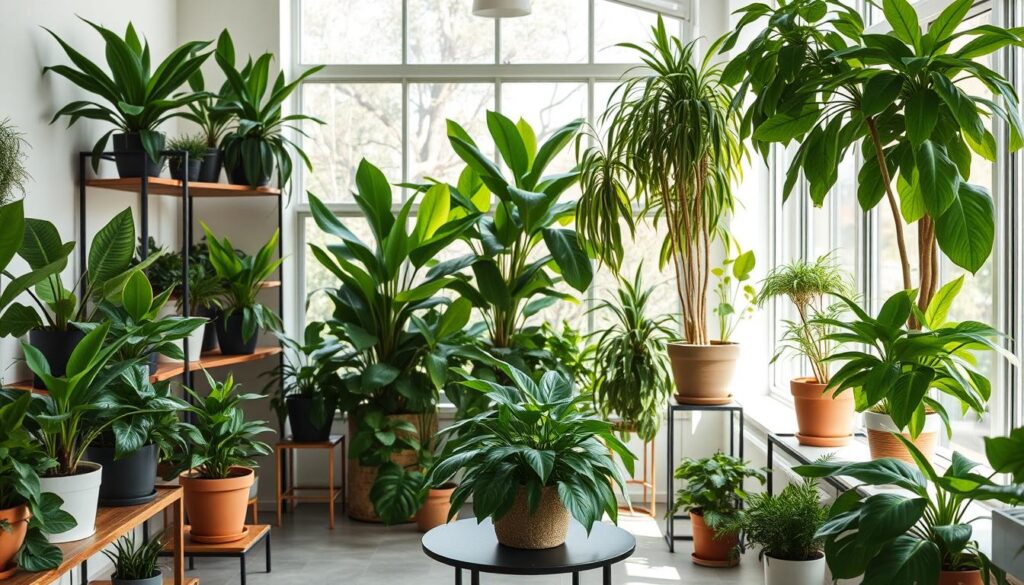
“Proper placement of air-purifying plants can significantly improve indoor air quality and reduce allergens for those suffering from respiratory issues.”
To get the most air-cleaning power from your indoor plants, think about where pollutants are, how well your home is ventilated, and how plants work together. With some planning, you can turn your home into a lush, allergy-friendly haven.
Creating an Allergy-Free Indoor Garden
If you or a loved one has allergies, making your indoor space allergy-free can help a lot. By picking the right allergy-friendly indoor plants, you can make a clean and hypoallergenic area. This area will clean the air and reduce exposure to common allergens.
Begin by choosing plants that clean the air in different ways. Peace lilies can remove formaldehyde and xylene, while snake plants are great at getting rid of benzene and trichloroethylene. Mixing these plants can make your home’s air cleaner.
When setting up your garden, use stable containers to avoid accidents. This is especially important if you live with seniors or people who have trouble moving. Also, stay away from plants with thorns or sharp leaves that could be dangerous.
- Choose easy-care, allergy-friendly plants like Boston ferns, spider plants, and Janet Craig plants to save time on care.
- Put your plants in the right spots for light and humidity to help them grow well and clean the air better.
- Keep your plants clean to stop dust, mold, and allergens from making the air worse.
Creating an allergy-free indoor garden lets you breathe better and enjoy the perks of allergy-friendly indoor gardening. You’ll get cleaner air and a calming, natural space.
Natural Allergy Relief Through Strategic Plant Selection
Choosing the right indoor plants can help with allergies at home. Pick plants that target specific allergens to make your home healthier. Use air-purifying plants, good ventilation, and regular cleaning for the best results.
The OPALS (Ogren Plant Allergy Scale) rating is important. It shows how likely a plant is to cause allergies. Look for plants with low OPALS ratings to avoid pollen and irritants.
| Plant | OPALS Rating | Allergen Reduction |
|---|---|---|
| Snake Plant (Sansevieria) | 1 | Removes formaldehyde, benzene, and trichloroethylene |
| Boston Fern | 2 | Reduces airborne mold and bacteria |
| Bamboo Palm | 2 | Filters out dust, pollen, and other airborne pollutants |
Using whole-house air cleaners with HEPA filters can also improve air quality. Place these plants strategically around your home. Keep humidity levels right and clean regularly for a healthier space.
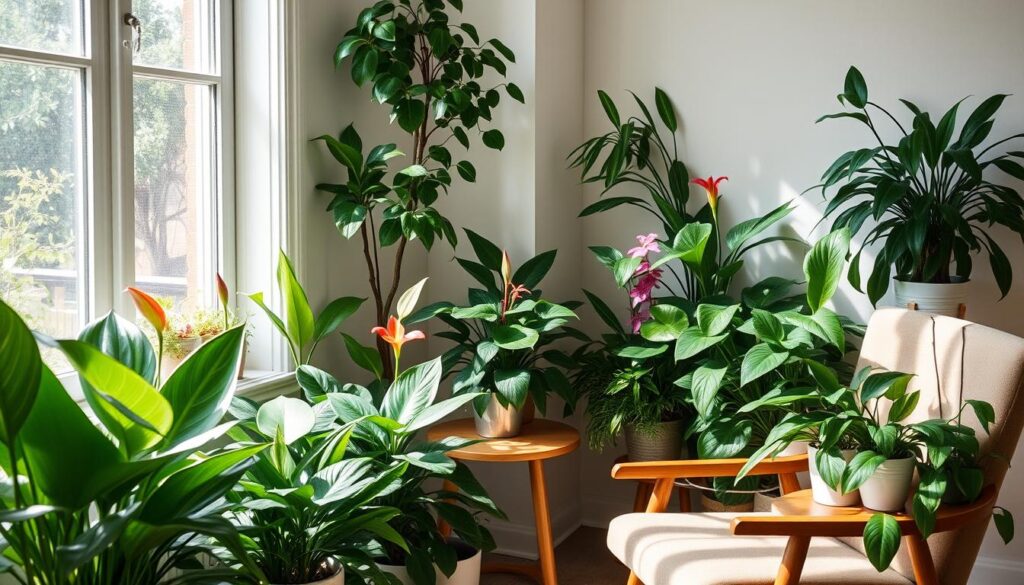
Everyone’s allergies are different, so try out various plants. By using natural allergy relief with houseplants and other methods, you can make your home a safe, allergy-free space.
Conclusion
Indoor plants are a natural way to improve air quality and reduce allergy symptoms. By picking the right plants and caring for them, you can make your home healthier. Look for plants with good OPALS ratings and that are safe for pets.
Choosing the best indoor plants for allergies helps you breathe better. Using natural allergy relief with houseplants makes your home more comfortable. With the right plants, you can improve your home’s air and reduce allergy triggers.
Adding these plants to your home is a smart move for your health. It makes your living space better for you and your family. Enjoy the clean air and comfort of a plant-filled home.
